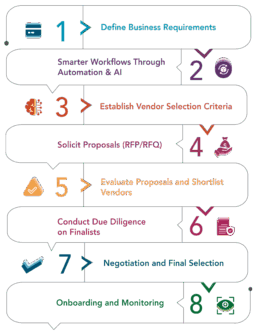
Introduction
Selecting the right vendors is critical for corporations, whether they’re a Fortune 500 company or fast-scaling startups. As global supply chains grow increasingly complex and interconnected, third-party suppliers are seen to directly impact cost, continuity, and reputation. Poor vendor choices can introduce serious risks while well executed selection ensures compliance, quality, and strategic alignment.
Key Steps in the Vendor Selection Process
Effective vendor selection processes are methodical, involving a series of steps from defining needs to finalizing contracts. By formalizing processes, organizations ensure no aspects get overlooked. Below are the key steps commonly adopted by the best performing corporations:

Define Business Requirements
Start by clearly defining the required goods or services, including scope, technical needs, budget, and compliance expectations. This clarity forms the foundation of all later steps and ensures all stakeholders agree on the objectives. At this stage, it’s useful to document business needs, desired vendor characteristics, and expected deliverables.

Research and Verify Potential Vendors
Conduct market research to find candidates through industry directories, trade shows, professional networks, or online platforms. Casting a wide net to identify prospective vendors that match the organization’s needs ensures competition and provides a basis for comparison. If necessary, issue a Request for Information (RFI) to gather preliminary details from potential vendors.

Establish Vendor Selection Criteria
Next, develop a clear set of criteria to evaluate vendors objectively. These criteria should be weighed for importance and alignment with the organization’s priorities. Common factors include product/service quality, price, delivery capability, technical expertise, financial stability, past performance, and compliance with regulations.

Solicit Proposals (RFP/RFQ)
Issue a Request for Proposal (RFP) for complex projects, and a Request for Quotation (RFQ) for more straightforward commodity purchases. RFP/RFQs are best practices as they communicate project needs, evaluation criteria, response format, and deadlines.

Evaluate Proposals and Shortlist Vendors
With proposals in hand, evaluate and score each vendor against the predefined criteria. It’s essential to consider not only the price tag but also the quality and value. Data-driven insights help to consider vendors’ performance metrics, customer reviews, and financial health. Utilize cross-functional evaluation committees to ensure well-rounded assessments.

Conduct Due Diligence on Finalists
Before making any final decisions, perform thorough due diligence on the leading candidates to verify that the vendor can deliver and uncover potential risks. Due diligence processes include reviewing the vendor’s financial statements, credit ratings and business reports, verifying certifications or licenses, and contacting references to inquire about past performance.

Negotiation and Final Selection
Enter contract negotiations with shortlisted vendors to set pricing, delivery terms, service-level agreements (SLAs), intellectual property ownership, confidentiality clauses, etc. Ensuring detail and clarity about party obligations allows for foresight through built-in flexibility and escalation procedures. After successful negotiations, award the contract to the selected vendor, formalizing the partnership.

Onboarding and Monitoring
Orient the vendor to the organization’s systems and communication channels in the onboarding process. Defining KPIs or metrics at the outset helps monitor the vendor’s ongoing performance, making vendor management (including delivery, quality, and compliance monitoring) an extension of the selection process through formalized feedback loops and issue resolutions.
Manually Vetting Vendors? Save Time, Reduce Risk, & Stay Compliant
Dun & Bradstreet’s Vend-R platform delivers verified, risk-rated vendor profiles in one place, cutting vetting time, supporting compliance standards, and helping you avoid exposure to unreliable or noncompliant suppliers.


A clearly defined vendor selection process helps corporations reduce uncertainty and make informed, high stakes decisions with confidence. By following these key steps, from defining business needs to onboarding and monitoring, organizations can ensure that each vendor relationship is built on a foundation of due diligence, strategic fit, and long term value. In the next blog, we’ll explore how to optimize these processes further by embedding best practices that improve efficiency, compliance, and performance across the procurement lifecycle.



